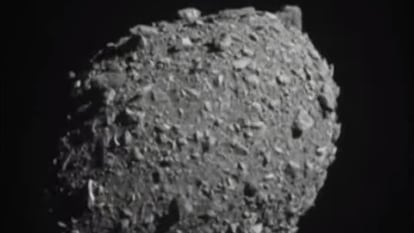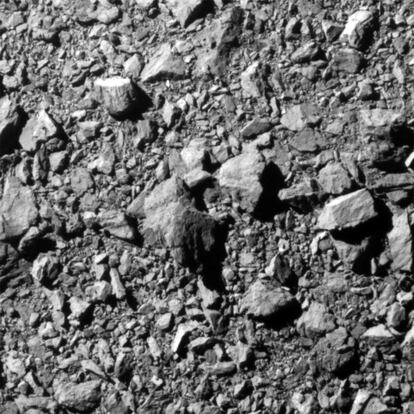How will we know if NASA’s DART probe succeeded in changing the course of an asteroid?
The Didymos-Dimorphos system moves like clockwork and telescopes will be able to observe changes in orbital frequency to determine if NASA altered it.

A few minutes after 23.00 UCT on Monday, NASA’s Double Asteroid Redirection Test (DART) probe crashed into its target, a small asteroid called Dimorphos, almost exactly according to schedule. At the speed of a bullet fired from a .44 Magnum, against a rock measuring 160 meters in diameter, 11 million kilometers from Earth, DART hit the bullseye.
The images transmitted by the probe’s in-flight camera during the final moments of its trajectory were truly spectacular. First the main asteroid Didymos, measuring 780 meters in diameter, and its orbiting moonlet, Dimorphos could be seen together. Then, as DART approached at more than six kilometers per second, Didymos disappeared from the camera’s field of view while Dimorphos gradually increased in size.
The last six or seven images transmitted by DART focus on the smaller asteroid, which in the space of just a few moments went from being a mere pixel of light in the blackness of space to revealing some superficial details and, finally, to high-resolution close-ups of its surface that had the entire NASA control team cheering.
Unlike other astroids, which tend to alternate between rough terrain and almost smooth expanses of dust, Dimorphos is literally studded with rocks. In the final image relayed back to Earth, which could only be transmitted in part due to the destruction of the probe on contact with the asteroid, surface details of less than an inch in size can be seen. And then, fade to red: “We have impact!”

Observatories to determine if Dimorphos has been diverted
But the big question remains: has NASA’s goal of diverting Dimorphos slightly out of its original orbit been achieved? Observatories around the world, from Chile to La Palma, Spain, will attempt to provide the answer in the coming weeks. An extensive, worldwide observation program is underway, consisting of a large network of telescopes in space and on earth that are trained on both asteroids to study them in detail before, during and after DART’s impact. It is hoped that in the course of the next few hours, days or weeks, these telescopes will be able to confirm if Dimorphos has been knocked off its previous trajectory, and by how much.
The Didymos-Dimorphos binary asteroid system is essentially a clock. Until NASA’s intervention, the smaller body made a complete revolution around its primary in 11 hours and 55 minutes. DART collided with Dimorphos in a counter-clockwise direction, so it should have caused a slight change in altitude, sending the asteroid into a lower orbit, and thusly a reduction of around 73 seconds in the time it takes to complete each revolution. Now, this “clock” should be moving forward.
Dimorphos was selected by NASA because – in addition to its binary nature – from Earth it is seen sideways on: approximately every 12 hours, when Dimorphos passes in front of Didymos, it produces a small eclipse. Giant telescopes are able to photograph it, while others can measure changes in brightness as it enters and exits the eclipse. There are even some radar systems capable of detecting any differences in orbital frequency. Now, the task of astronomers will be to measure the interval between each two successive appearances of Dimorphos. According to calculations, it should be about a minute shorter than it was before. If confirmed, this will provide compelling evidence that for the first time in history, a celestial body has been moved by human intervention.
Tu suscripción se está usando en otro dispositivo
¿Quieres añadir otro usuario a tu suscripción?
Si continúas leyendo en este dispositivo, no se podrá leer en el otro.
FlechaTu suscripción se está usando en otro dispositivo y solo puedes acceder a EL PAÍS desde un dispositivo a la vez.
Si quieres compartir tu cuenta, cambia tu suscripción a la modalidad Premium, así podrás añadir otro usuario. Cada uno accederá con su propia cuenta de email, lo que os permitirá personalizar vuestra experiencia en EL PAÍS.
¿Tienes una suscripción de empresa? Accede aquí para contratar más cuentas.
En el caso de no saber quién está usando tu cuenta, te recomendamos cambiar tu contraseña aquí.
Si decides continuar compartiendo tu cuenta, este mensaje se mostrará en tu dispositivo y en el de la otra persona que está usando tu cuenta de forma indefinida, afectando a tu experiencia de lectura. Puedes consultar aquí los términos y condiciones de la suscripción digital.
More information
Últimas noticias
Mustafa Suleyman: ‘Controlling AI is the challenge of our time’
Venezuela breaks energy agreements with Trinidad and Tobago due to alleged complicity with the US
The murder of Michele and Rob Reiner: A tale of horrific days in Hollywood
Trump orders a ‘complete blockade of sanctioned oil tankers’ going to and from Venezuela
Most viewed
- ‘El Limones’ and the growing union disguise of Mexican organized crime
- Christian Louboutin: ‘Young people don’t want to be like their parents. And if their parents wear sneakers, they’re going to look for something else’
- ‘We are dying’: Cuba sinks into a health crisis amid medicine shortages and misdiagnosis
- A mountaineer, accused of manslaughter for the death of his partner during a climb: He silenced his phone and refused a helicopter rescue
- The low-cost creative revolution: How technology is making art accessible to everyone










































